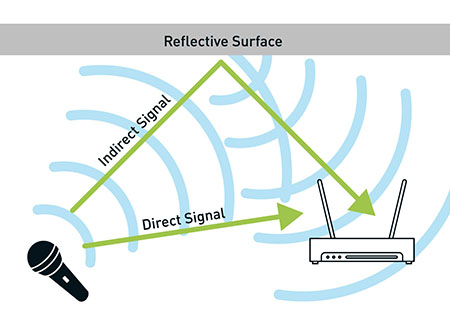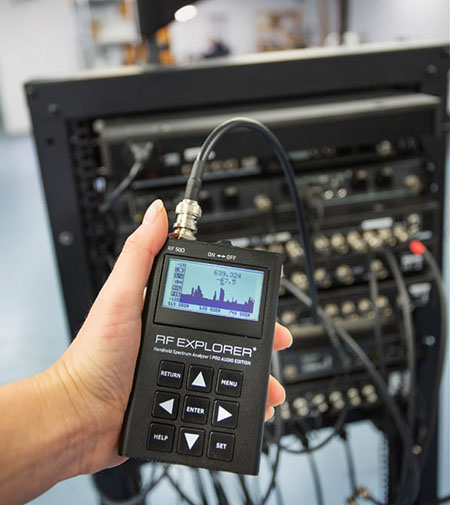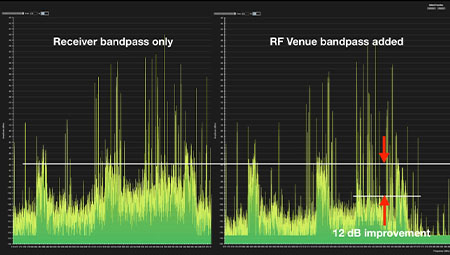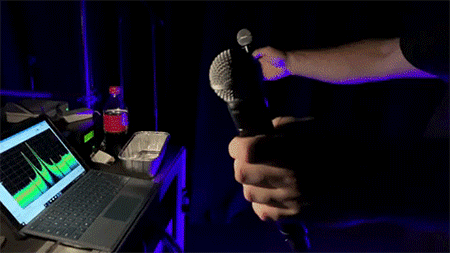By Don Boomer from RF Venue
Wireless microphones are prone to interference, noise, drop-outs, and many other RF Definition:
Definition:
(Radio Frequency) Electromagnetic radiation through the air, or electrical signals in cable. Typically, RF frequencies are above 100 kHz. problems.
These problems can be disastrous for both live productions and installed systems. Everyone can recall a time when a wireless mic suffered static or intermittent dropouts during a live event. Malfunctions lasting even a fraction of a second can throw off presentations and performances- driving technical crews, event coordinators, and audiences crazy. Below are the three most common problems, and a few basic techniques to solve them.
1. Multi-path Interference
Multi-path interference is when portions of RF energy arriving at the receiver's antenna Definition:
Definition:
A device for radiating or receiving electromagnetic signals. at slightly different times. You may remember an example of this as "ghosts" in the analog Definition:
Definition:
A signal that is continuous in nature, as opposed to being defined as a series of discrete numbers (or elements) as found in digital signals; electrically "analogous" to an acoustical signal in the air. TV days. Radio waves always travel as straight lines, so to get around a corner they must bounce Definition:
Definition:
1. Reflecting ambient or sun light back to a filmed object. 2. In recording, to play back one or more tracks for recording into a different track (or sometimes, tracks), or to copy one track to another.. As a transmitted wave spreads, it encounters surfaces that reflect or absorb different parts of the wave. As these waves bounce off of and around surfaces, they arrive at the receiver at slightly different times and thus out of phase—creating dropouts and dead-spots for wireless microphones. Also the polarity Definition:
Definition:
1. In electricity, the quality that indicates whether the pole of a direct current device like a battery has more electrons than the other (negative polarity) or fewer electrons than the other (positive polarity), which relates to the direction of current flow. 2. In audio, a reference to whether a point in a signal is above or below the zero voltage line (positive or negative, respectively). Reversing polarity "flips" a signal so that if a point in its waveform was positive, that point will be negative instead. Often confused with phase. See: Phase. of the wave flips 180 degrees every time it reflects off a surface. When these signals mix in your antenna they almost always cause signal cancellation and therefore drop outs. This is a common problem for wireless microphone Definition:
Definition:
A microphone with a transmitter that sends radio-frequency signals to link wireless with a receiver, obviating the need for a cable. systems indoors, where there are a multitude of opportunities for RF to reflect off surfaces.
Multi-path is particularly problematic for microphones since they are constantly in motion and changing angles. So before showtime, diagnose your performance space for multi-path by simulating the motion of the talent, and walk around the entire area with a mic while monitoring RF signal level and audio at the receiver position.
Reducing multi-path interference is usually straight forward. The diversity Definition:
Definition:
Use of two antennas on a wireless receiver to reduce dropouts caused by multiple reflections or signal blockage. microphone receiver was designed to reduce interference caused by multi-path, and virtually all professional mic systems use this scheme today. They use two antennas that have different perspectives, instead of one, and employ a switching function that discriminates between the relative strength of the two signals. The odds that a null develops at both antennas is much lower than with a single antenna. Manufacturers use multiple schemes for diversity and some work better than others.
However, the design of the diversity receiver can solve one problem while introducing another: a poor signal will often cause the system to rapidly switch back and forth between antennas, leading to quick dropouts and "swooshing" sounds caused by switching noise.
If your system encounters multi-path interference the first thing to do is to re-locate your receivers—or better yet, install a good remote Definition:
Definition:
A broadcast from the field, not from the studio. A Remote Control. antenna system. Employing a polarization diversity antenna like the Diversity Fin will eliminate cross polarization dropouts by providing the receiver with an improved signal on both branches of the diversity switching function. It doesn't drop out! This causes receivers to maintain quality signal without all the switching and signal dropouts.
2. Noise Floor and Interference
 It's important to understand that all environments are a soup of radio waves. Most of that energy is caused by other electronic devices emitting stray (unintended) RF—computers, video walls, LED
It's important to understand that all environments are a soup of radio waves. Most of that energy is caused by other electronic devices emitting stray (unintended) RF—computers, video walls, LED Definition:
Definition:
LED (Light-Emitting Diode): A semiconductor light generator used in displays, television, pointers and for general illumination. It is a low-power replacement for incandescent lamps. lighting, power supplies, anything with a motor–just about any powered device. And even in the remotest desert, cosmic radiation and natural radiation generated by the earth causes noise. Worse yet, noise is often intermittent- present during show time but gone the next day.
An RF system—like a wireless microphone—needs a sufficient signal-to-noise ratio Definition:
Definition:
Abbreviated SNR. The ratio in dB between the noise floor and a nominal signal level (not the maximum level, which instead defines the Dynamic Range. See Dynamic Range.) (AKA - carrier-to-noise ratio) to stay above this ever-present ambient Definition:
Definition:
1. Something in a close vicinity. 2. The natural sound of a space, or simulation of being in that space. noise “floor.” Maintaining high signal-to-noise ratio for your wireless mics is aided by isolating the signal and directing it to only where it is needed. In general, the closer the wireless receivers (or remote antennas) are to the wireless mics, the better. This provides the transmitter Definition:
Definition:
Any device that sends an electrical signal, typically radio waves or by wire. and receiver a shorter distance and stronger signal, which presents a higher signal over the noise floor Definition:
Definition:
The unalterable, lowest noise level within a system, measured in dB. For example, microphone preamp hiss might set the noise floor in a recording situation., which usually doesn't change, at the receiver.
We would hope that the ambient noise floor at our venue is about -80dB or lower but with some planning and the use of best practices, noise floors of -70dB and higher are usually workable. Here's how to measure the noise floor and interference at your location with an RF spectrum analyzer–a must have in today's increasingly crowded RF environment.

"Paddle" or "shark fin" antennas may have difficulty keeping up in the presence of these higher noise floor scenarios so selecting a local field antenna like the Spotlight Definition:
Definition:
A lighting fixture with ellipsoidal reflector and two lenses. Also known as Leko or Ellipsoidal. Antenna can isolate reception and decrease the amount of noise entering the signal chain, significantly opening up even the most crowded RF environments to accommodate your system. Additionally, adding the appropriate Band Definition:
Definition:
A grouped range of frequencies, usually with a commonly used designation. Pass Filter Definition:
Definition:
1. (audio) A circuit that reduces certain frequencies, e.g., a low-pass or high-pass filter for audio. See also: Equalizer. 2. (optics) reduces certain color wavelengths or polarizations. can typically reduce your noise floor by 6 to 15 dB Definition:
Definition:
1. A deciBel is a logarithmic ratio between two quantities, and is a nonlinear measurement that mimics human perception. 2. A unit expressing sound levels relative to a nominal level just audible by the average human ear, and equal to 1/10th of a Bel. 3. (slang) Database.. The use of top quality, 100% shielded coax cables can reduce the ingress of stray RF into your system as well. Using these specialized antennas and signal management techniques can be the difference between success and failure.
3. Intermodulation Distortion and Frequency Coordination

Frequency coordination is essential in wireless systems to avoid not only third party transmitters but also the harmful effects of Intermodulation Distortion Definition:
Definition:
Undesirable distortion caused by the interaction of two or more signals that create harmonics not related to the input signals. (also referred to as IMD or "intermod"). IMD is the result of two or more signals passing through a non-linear device, such as a diode Definition:
Definition:
1. An electronic component that converts AC into DC. 2. A protection device so that reverse currents can't destroy components that are damaged by reverse polarity. 3. The component that adds distortion to many effects boxes and other signal processors. or an amplifier Definition:
Definition:
1. A device that increases the voltage or power of a signal. 2. In music performance, a device such as a guitar amplifier that includes speakers and controls to increase the sound level of acoustic or electric instruments.. IMD manifests as ghost signals from wireless mic bodypack or handheld transmitters. These appear at predictable frequencies in the RF spectrum. If these ghosts are too close to one of the frequencies used by your microphone, audible distortion Definition:
Definition:
A change in an electronic or acoustic signal's waveform. This can undesirable if it impacts signal quality, or desirable when used for creative signal processing. can result.
By carefully selecting frequencies, you can force the IM Definition:
Definition:
See: Intermodulation. to occur only at frequencies that we don’t care about, and avoid those interference events altogether. This is most commonly achieved through determining an "intermod-free" set of frequencies, which can be accomplished through various software tools like Shure's Wireless Workbench, IAS, Wireless Manager and even onboard some receivers. But getting an elegant solution from these programs requires providing them with the best possible data. Many users connect their receivers as the scanning input, but remember, a receiver can only input the band it can receive and so no out of band information is provided for the calculations. A much better solution is to use a dedicated spectrum analyzer like the RF Explorer Pro Audio Edition.
The importance of frequency Definition:
Definition:
A value, expressed in Hertz, that indicates how many cycles of a periodic signal occur in one second. co-ordination in today's scene can not be understated as the wireless landscape continues to evolve with more and more devices competing for less available spectrum. Moving towards the July 2020 deadline for repacking the UHF Definition:
Definition:
(Ultra High Frequency) Radio-frequency band spanning 450 MHz to 952 MHz. Commonly used for wireless microphones and broadcast television. band, it may become very difficult to use wireless mics without the frequency selections derived by these algorithms. So with each new spectrum change the challenges faced by audio professionals multiply. But thankfully, new methods and technologies are emerging to confront these problems and narrow the gap between the performance of wired and wireless systems. Be sure to examine other posts in our blog and subscribe to get bi-monthly updates on the latest.
Read other GearCast articles featuring RF Venue:
- Is Your Church's Wireless System Ready? by Chris Regan
- Keeping Wireless Mics On the Air by Don Boomer

















